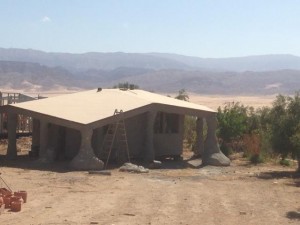There is a great deal of disagreement as to whether lightweight construction is good for the environment or not. On one hand, non-natural materials are used in lightweight construction, some of which are not even perishable. On the other hand, there are many advantages to lightweight construction, such as reduction of the amount of work required, in transport and materials, and it prevents damage to the ground.
The first stage is installation of a framework for the floor which is made up of posts on which a metal framework is placed. The construction of the structure rests on this framework. The structure is leveled according to the ground in such a way that there is air space in between the structure and the ground. This gap is used to accommodate all of the infrastructure in a way which is both comfortable and high quality. This type of framework eliminates the need for earthwork which damages the ground and also requires heavy machines which emit pollutants.
The building on the Arandal Ranch is directed by farm founder Dani Cohen, together with the architect Udi Benyamini. The lightweight structures on the ranch will serve as guest houses. The family members feel that this is the best type of building for them and for the location. After considering all the aspects, the advantages were found to outweigh the disadvantages. “We have no problem working with materials that are seemingly not ecological.” The intention is to use classic building materials such as mineral plaster, wood surfacing, iron and tin construction, which are not considered ecologically sound. “We feel that these materials were invented for a reason, and that they have added value which doesn’t exist in natural materials. Sometimes their affect on nature is not so bad, such as in the question of transport, which is significantly detrimental. Building with mud bricks, which is ecologically sound, requires delivery of at least three truckloads of clay. In addition, the contractor is required in order to move the clay during building. All of this is not required for lightweight construction, particularly and mainly in the remote Arava region which necessitates longer transport times. Building on the Arandal Ranch on an area of 1200 m² required removal of less than two tons of waste materials, which is significantly less than that required in classic building methods. 
In fact, relatively little transport is required in lightweight construction, nor are massive machines, and relatively little maintenance work is required over the years. The use of durable materials, even if they are manufactured, makes high quality building possible, which can last for 50 years and more. In comparison, building with mud bricks requires application of flax oil at the beginning of each winter, as well as maintenance work each year in order to fix cracks and strengthen the structure. Labor is an expensive factor in the Western world, particularly if the workers have to be brought in from a distance. The reduced use of labor therefore also saves money and is ecologically sound.
One of the most divisive issues regarding lightweight construction is the use of polystyrene foam panels for insulation. Insulation is a complicated issue in itself, and no one method has all the advantages. In lightweight construction the structure itself does not have thermal mass, but use of materials such as polystyrene foam creates excellent thermal insulation (such as is used in refrigeration works). 10-15 centimeter panels are used, which form very thin walls which are very light and insulate extremely well. High-quality insulation directly results in saving electricity, which obviates the need for powerful air-conditioning. It is true that polystyrene foam is not a natural material, but the approach in lightweight construction is that everything has a price. For example, there is ecological building in some places in which tires are put inside the walls in order to save on material. These are indeed tires which have already been used, thereby fulfilling the principal of re-use. However, using them in this way is in lieu of storing them in the correct manner which is accepted by industry standards. These tires sit within the walls of houses in which people are living, where they are broken down into the ground over time. Dani Cohen adds that “All methods have advantages and disadvantages. Very little polystyrene foam is used; the panels are only a few centimeters thick. In my view, a building which is so light and airy, with almost no mass, cannot have a very damaging effect. It’s important to remember that at the end of the day approval of proper building standards has to be received (form no. 4), as well as a permit from the fire dept., and therefore I believe that this is the lesser evil”.
The interior walls, ceilings and roof on Arandal are built with OSB panels (crushed wood). “This is a great raw material from which many things can be made without the need for professional labor”, says Cohen, “this type of construction can be put together within a few days using only electric screwdrivers. The structures have excellent thermal results, can withstand earthquakes, are termite-resistant and everything can be done on your own, in modular units, giving complete architectural freedom”.
The unique architectural language created by Cohen and Benyamini is an important part of the Arandal Ranch project. The high location provides good exposure for the buildings from the road (Highway 90), and therefore particular emphasis was placed upon fitting into the landscape. “The choice of lightweight construction came partly from our familiarity with the desert and the character of the location. Landscape architecture has to be combined with structural architecture. The buildings are somewhat crazy to implement. Each roof has 16 non-symmetrical polygons so that the skyline of each building blends into the surrounding skylines and colors. It looks like asymmetrical polygons, and looks different from each angle from which it is viewed. It’s not a coincidence that Bedouin tents also look like this. They are also designed to fit into their surroundings and that’s exactly what’s going on here. Building a roof that has angles of 27.4° and another angle of 29.3° with conventional building methods with cement and heavy iron would be a megalomaniac enterprise bordering on the impossible. With lightweight construction it’s easy, the building methods allows independent work with non-routine architecture”.
